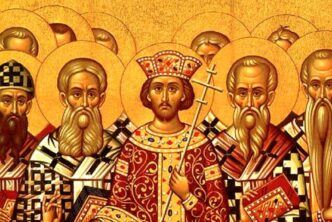The Verbum monthly sale is featuring several works of St Thomas Aquinas.
Here’s an excerpt from Commentary on the Gospel of John: Chapters 1-5, part of the 8-volume set, Thomas Aquinas in Translation.
Get a hint of the capacious and lucid intellect of St. Thomas in his Prologue to the Gospel of John:
I saw the Lord seated on a high and lofty throne, and the whole house was full of his majesty, and the things that were under him filled the temple (Is. 6:1)
These are the words of a contemplative, and if we regard them as spoken by John the Evangelist they apply quite well to showing the nature of this Gospel. For as Augustine says in his work, On the Agreement of the Evangelists: “the other Evangelists instruct us in their Gospels on the active life; but John in his Gospel instructs us also on the contemplative life.”
The contemplation of John is described above in three ways, in keeping with the threefold manner in which he contemplated the Lord Jesus. It is described as high, full, and perfect. It is high: I saw the Lord seated on a lofty throne; it is full: and the whole house was full of his majesty; and it was perfect; and the things that were under him filled the temple.
As to the first, we must understand that the height and sublimity of contemplation consists most of all in the contemplation and Knowledge of God: “Lift up your eyes on high, and see who has created these things” (Is. 40:26). A man lifts up his eyes on high when he sees and contemplates the Creator of all things. Now since John rose above whatever had been created—mountains, heavens, angels—and reached the Creator of all, as Augustine says, it is clear that his contemplation was most high. Thus, I saw the Lord. And because, as John himself says below (12:41), “Isaiah said this because he had seen his glory,” that is, the glory of Christ, “and spoke of him,” the Lord seated on a high and lofty throne is Christ.
Now a fourfold height is height is indicated in this contemplation of John. A height of authority; hence he says, I saw the Lord. A height of eternity; when he says, seated. One of dignity, or nobility of nature; so he says, on a high throne. And a height of incomprehensible truth; when he says, lofty. It is in these four ways that the early philosophers arrived at the knowledge of God.





Thank you. I love trying to understand St. Thomas Aquinas. I believe he is said to be the most brilliant man that ever lived. If I can grasp just a bit of what he says, I feel grateful. I will need to re read this more than once to absorb it. “Thomas Aquinas in Translation” looks awesome.
Well I will have to read bits and pieces here and there.
Wish it would be sent to my inbox weekly in segments!
This is great for now! I love it! Thank you.